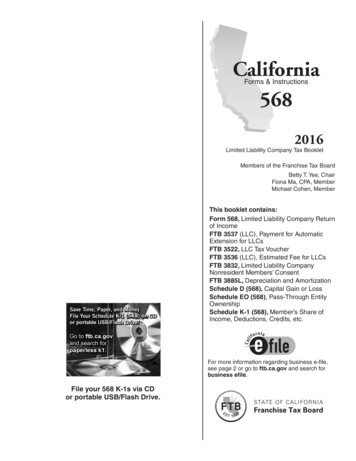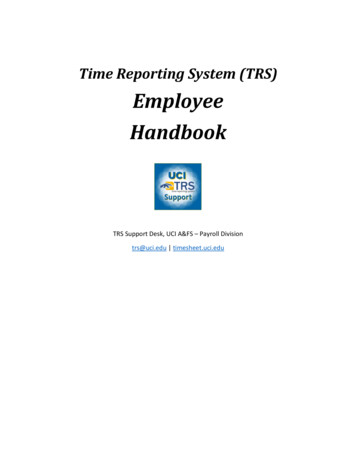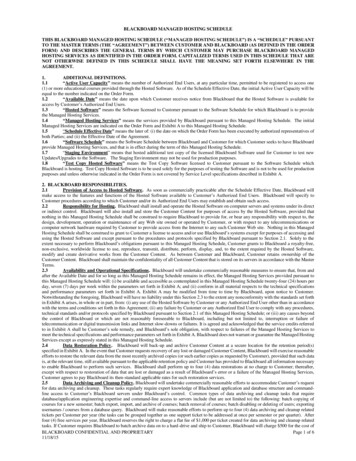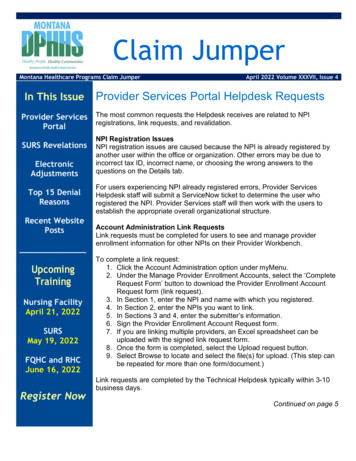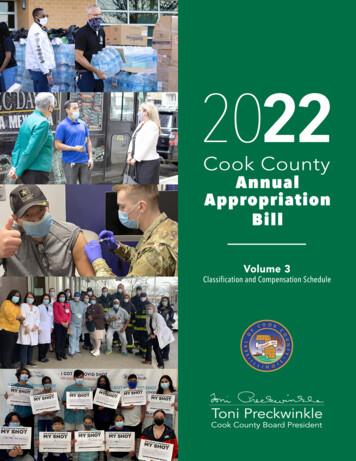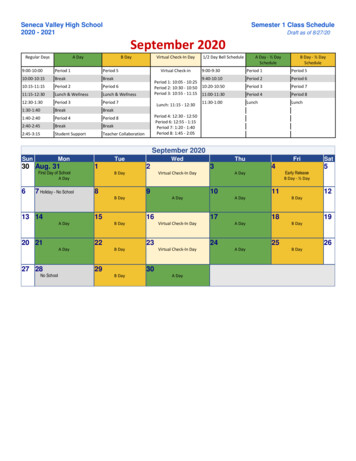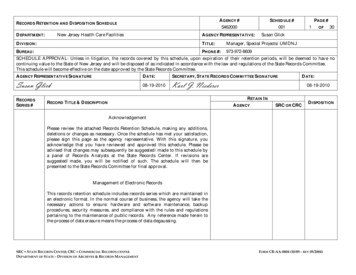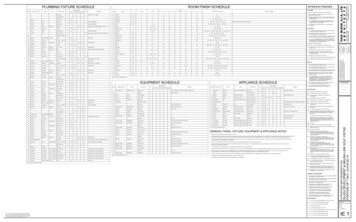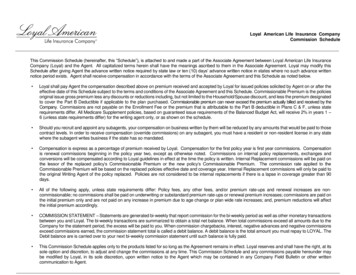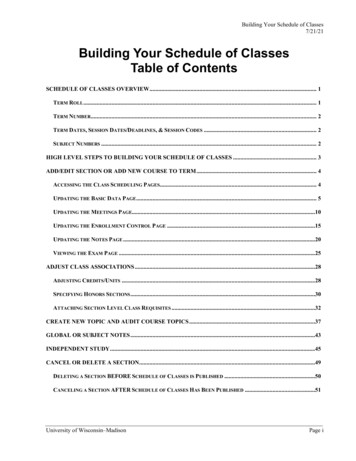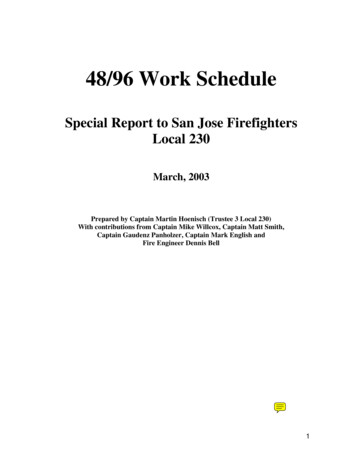
Transcription
48/96 Work ScheduleSpecial Report to San Jose FirefightersLocal 230March, 2003Prepared by Captain Martin Hoenisch (Trustee 3 Local 230)With contributions from Captain Mike Willcox, Captain Matt Smith,Captain Gaudenz Panholzer, Captain Mark English andFire Engineer Dennis Bell1
48/96 Work ScheduleIn April of 2001 Fire Administration and line personnel were provided with aninformational packet discussing the benefits of '48/96' work schedule for line personnel. InJune of 2001 the Local 230 membership passed a referendum vote to “initiate, through dueprocess, a one-year trial of the schedule”. A committee was then formed to gatherinformation from departments across the state and nation who work the 48/96. This reportalthough not perfect, is the result of many hours and days that committee members havespent in their attempt to gather accurate and factual information for the membership ofSJFD. The vast majority of the information presented in this document comes directlyfrom departments who work the 48/96.If Fire Administration and the City agree to the trial period, another vote by themembership of Local 230 will be held to ratify or deny the schedule change.It is the recommendation of the 48/96 Committee that the 48/96 schedule change beimplemented on a trial bases. In addition, the Committee recommends that an escapeclause” be written into the schedule change.An escape clause would allow any of the involved parties, ie. The Membership of Local230, Fire Administration, or the City of San Jose, to cancel the schedule change and revertback to the Kelly schedule at any time, should any serious issues arise that jeopardizessafety, productivity or the monetary concerns of the SJFD or the City of San Jose.The 48/96 is currently being negotiated with the City and Fire Administration by ourcontract negotiating team as mandated by the original referendum vote.The 48/96 and the Fire ServiceThe 48/96 has been utilized by professional fire departments since the early 1990s.The committee found the use of the"48/96" or "2's and 4's" to be widespread and rapidlygaining in popularity, with over 2 dozen departments switching to the 48/96 in the last 5years. As seen on the attached list, this schedule is not a theoretical experiment in the fireservice but a proven and valid schedule option. The Departments using the schedule arediverse in their demographics, management structure, and overall philosophies.Comparable Fire Departments working the 48/96Out of the dozens of departments that work the 48/96, Albuquerque, New Mexico1 and SanBernardino City Fire were found to be our best comparable departments, based on servicesprovided and call volumes.Albuquerque Fire has 21 stations, protects a population of 625,000, provides ALS servicesand responds on over 50,000 calls a year. Six of Albuquerque’s 21 stations run between350 and 500 calls a month, comparable with our stations 1, 2, 3, 18 and 26. Albuquerquehas been working the 48/96 5 years. Early last year, two members of the 48/961Although Albuquerque did not work a Kelly schedule before switching to the 48/96, the fact that thisdepartment closely parallels SJFD in regards to services provided, and in call volume, it therefore provides anexcellent comparable department for day to day operations and the 48/96.2
Committee spent two days in Albuquerque with both fire administration and line personnelin order to get a first hand look at the 48/96 in a busy metropolitan department.The City of San Bernardino Fire Department has 11 fire stations, protects a populationof XXX,XXX and responds on over XXXXX calls a year. Three of San Bernardino’sEngines stations run between 350 and 500 calls a month placing them among the highestvolume companies in the United States2.Other departments, mostly throughout California, were used as a source of information onthe transition from the Kelly Schedule (3/4) to the 48/96, along with day to day operations.Bay Area departments that were studied include; City of San Mateo, Hillsborough, UnionCity and Burlingame FireOne of the more telling findings the 48/96 Committee identified was that all of thedepartments working the 48/96 share an overwhelming level of satisfaction with theschedule.Research was conducted on a wide variety of topics, with interviews with all ranks fromFirefighters to Fire Chiefs, providing the committee with a broad perspective. It isnoteworthy that all agencies instituted the schedule on a trial basis and after the trial none ofthe agencies chose to return to their previous schedule. Included is as an attachment is listof departments that are known to be working the schedule, as well as departmentsresearching implementation.Comparisons of the 4896 vs the Kelly SchedulesSJFD currently works what is commonly called, the Kelly schedule or ¾ schedule. Theexample below uses the A-shift as an example of how the 48/96 compares to theKelly. (Also see the attached sample schedule for an entire year)X 24 Hour work daysO Off DaysKelly Schedule (current)ACABA BCBC ACABA BCBCA-shiftXOXOX OOOO XOXOX OOOO3 Shifts working 56 Hours a week48/96 Schedule (proposed)AA BBCC AA BBCC AA BBCC AAA-shiftXX OOOO XX OOOO XX OOOO XX3 Shifts working 56 hours a weekAs shown in the example the number of shifts and hours worked remains identical, only theconfiguration of the hours changes. An important finding verified by the SJ Finance2Source San Bernardino City Fire Department Fact Sheet3
Department is that there will be no change in the FLSA payout schedule (See letter fromFinance Dept. with attachments.)The committee found numerous benefits to this schedule including the followingquantitative benefits; a 50% reduction in commute time, reductions in sick leave use, and a50% reduction in holdover costs.48/96 and Kelly Schedules are both: 3 Platoon, ABC 56 hours per week 112 hours per pay period 121 shifts per yearKelly 9 day work cycle Rotation jumps ahead two days each cycle: Monday/Wednesday/Friday,Wednesday/Friday/Sunday. For a given day, example Monday: work 3 consecutive Mondays, off next 6consecutive Mondays48/96 6 day work cycle Rotation falls back one day each cycle: Thursday/Friday, Wednesday/Thursday,Tuesday/Wednesday. For a given day, example Monday: work 2 consecutive Mondays, off next 4consecutive MondaysFour Days OffKelly 40 per year48/96 60 per year 20 more (50% increase)Mornings at Home (not traveling to or from work)Kelly 3 of every 9 33% of mornings at home 120 per year48/96 3 of every 6 50% of mornings at home 180 per year 60 more (50% increase)4
Schedules ComparedWeekend RotationKelly48/96Sat / Sun.XOXOXOOOOOOXOXOXOORepeatSat / Sun.OXXXXOOOOOOORepeatX 24 hour shift on duty, 0 24 hours off duty.Complete Weekends OffKelly 3 out of 9 33% of weekends off 17 per year48/96 3 out of 6 50% of weekends off 26 per year 9 more (50% increase)Work One Weekend Day (Sat or Sun)Kelly 35 per year48/96 17 per year 18 less (50% reduction)Work Both Saturday and SundayKelly None48/96 9 per year5
Shifts falling on December 24 & 25The schedule we propose uses an adjustment that assures no shift will have to work bothChristmas Eve and Christmas Day. This is the same schedule used by departmentscurrently working the 48/96. The adjustment is only needed every other year; it is simpleand does not negatively affect any one shift. With the 48/96 each shift will work thesame number of holidays as with the current schedule. A similar adjustment can be madefor New Years Eve Day and New Years Day if the membership wishes. (See attachedHoliday Adjustment Calendar)Schedules ComparedAnnual Vacation Usage (maximum consecutive days off)1 shift leave 2 shifts leave 3 shifts leave 4 shifts leave 6 shifts leave 7 shifts leave 8 shifts leave 9 shifts leave 10 shifts leave 11 shifts leave 12 shifts leave Kelly6 days off8 days off13 days off15 days off22 days off24 days off26 days off31 days off33 days off35 days off40 days off48/965 days off10 days off11 days off16 days off22 days off23 days off28 days off29 days off34 days off35 days off40 days offFatigue and the 48/96Many employees support the 48/96 because of the fact that over time the schedule cansignificantly reduce fatigue.Prior to the schedule change, many individuals where concerned about possible increasesin fatigue resulting in the schedule change. The departments found that after the schedulechange, the issues of increased fatigue were not realized. In regards to short-term fatigue,members stated that their levels of fatigue were comparable or higher on the 3rd shift ofthe Kelly schedule, which offers no significant rest periods between shifts, whencompared with the second shift of the 48/96.Departments that have switched to the 48/96 schedule have seen no increases in injuriesor disabilities resulting from the schedule change. In addition many departments haveseen a reduction in sick leave use and all departments contacted stated that they have seenincrease in morale as a result of the change. These positive findings can be attributed inpart to a reduction in long-term fatigue.Short-term fatigueShort-term fatigue can be defined as consecutive hours without a significant amount ofsleep. Once adequate sleep has been obtained, cummulated lack of sleep leads to longterm fatigue (see below).6
During busy periods short-term fatigue would be expected to increase for someindividuals working the 48/96.Short-term fatigue also exists with the Kelly (3/4) schedule and with any schedule wherean employee can be expected to work for extended hours. Employees working extendedshifts, 48s & 72s, is not new to the SJFD. Due to overtime and or trades, employeesfrequently work 48s and 72 within the Kelly schedule framework in the SJFD withoutany significant issues or problems with fatigue. In fact, just about every day of the yearwe have employees either beginning or ending a 48 or 72 hour shift. It is also true thatwith both schedules, employees can be madatoried up to 72 hours with little concern forlong term fatigue. Independent of which schedule we work we will have exceptionallybusy shifts or periods from time to time, which will require adjustments to the dailyroutine, that’s the nature of the fire service in a metropolitin area. Departments wecontacted, felt that short-term fatiuge was not any more of a significant issue than withother work schedules.Short-term fatigue becomes an serious issue when coupled with long-term fatigue.One of the biggest advantages of the 48/96 is that it allows employee more oportunity torecover from sleep deprivation/ long-term fatigue.Long term fatigueLong-term fatigue can be defined as the accumulation of fatigue that lasts over weeks,months or longer periods without adequate rest periods. Long-term fatigue is morehazardous to employees in emergency services than short-term fatigue because the bodyis less able to compensate for the lack of rest than with short-term fatigue.The 48/96 schedule decreases long term fatigue in four ways;1.The 48/96 increases rest periods (4-days) by 50%, increasing the number fromform 40 to 60 a year. Everytime an employee leaves work he goes on a 4day/rest period. In addition, the frequency of “4-days increases to a “4-day”every 6 days as opposed to every 9 days with the Kelly schedule.An employeewho works overtime shifts during their “4-days” sees his/her percentage of “4days” increase even more significantly. For example, an employee who works anaverage of 10 overtime shifts a year, during their “4 days”, can see an increase of“4-days” of 67% from 30 to 50 a year3, while an employee who works 20overtime shift a year, during their “4 days”, can see a 100% increase in thenumber of “4-day” on an annual basis from 20 to 40 a year.2.The 48/96 increases the number of “sleep in days” (days waking up at homeand not going to work) by 60%, increasing the number from 9 to 15 per month.Working overtime shifts during employees “4-days” has a similar effect inincreasing the percentage of “sleep in days” when compared to the Kellyschedule.3On Kelly schedule: working 10 overtime shifts during “4-days” decreases the number of “4-days” from40 to 30, on the 48/96: working 10 overtime shifts during “4-days” decreases the number of “4-days” from60 to 50. – On Kelly schedule: working 20 overtime shifts during “4-days” decreases the number of “4days” from 40 to 20, on the 48/96: working 20 overtime shifts during “4-days” decreases the number of “4days” from 60 to 40.7
3.The 48/96 reduces the number of days/hours an employee spends getting readyfor work and time in the commute by 50%. A reduction of time spent in thecommute reduce both stress and fatigue.4.The 48/96 is more forgiving for employees working overtime or trades. Asshown in item #1, an employee working the 48/96 can work 20 additional shifts ayear and still have the same number “4-days” (rest periods) a year (40) as anemployee working the Kelly schedule who works no additional shifts. Inaddition, the 48/96 increase the number of days an employee can work a trade orovertime shift without it resulting in a 48 or 72. Because the schedule increasesthe number of “4-days” by 50%, the employee has 10 days/month to work anadditional shift without it resulting in a 48 or 72. Our current schedule onlyallows 6-7 days/month.Due to the reductions in long-term fatigue and stress, employees are better able to handleshort-term fatigue and stress resulting from busy shifts, or from working additional days(OT & Trades), resulting in a quicker recovery periods.Sick Leave and the 48/96 ScheduleBackgroundAnnual costs for sick leave use in the San Jose Fire Department was 1.2 million dollars in2000, 1.3 million dollars in 2001, and is projected to exceed 1.8 million for 20024. Dueto the high cost of sick leave use in the SJFD and the possible reductions in sick leave useassociated with the 48/96, the schedule change could result in significant saving to theSJFD.Many departments that have switched from the 3/4 schedule (Kelly schedule) to the48/96 have reported significant reductions in sick leave use after switching to the 48/96.None of the departments that we have contacted have reported any increases in sick leaveuse as a result of the schedule change.AnalysisThe general consensus is that switching to the 48/96 has had either a neutral or positiveeffect on reducing sick leave usage5. Reasons for the reduction could be the result ofmany factors including some or all of the following; improved morale, decreases in longterm fatigue or simply that the 48/96 schedule virtually eliminates the majority of sickleave abuse on the 2nd shift (which accounts for 50% of work days).Accurate data that demonstrates direct reductions in sick leave use as a result of theschedule change has been a challenge to obtain. “Useable” data is difficult to obtain, inpart, because sick leave use is dependent on many factors, including those not related to awork schedule. For example, in small departments one or two long term non-workrelated illness or injuries could significantly skew sick leave trends.4City of San Jose Payroll DepartmentThe 48/96 Committee has made formal contacts with over a dozen departments that have changed theirwork schedule to the 48/96, in addition to many informal contacts.58
The 48/96 Committee is continuing our attempts to gather accurate data regarding theeffects that the 48/96-schedule change has on sick leave use. The following are some ofthe departments that provided us with sick leave data.Pacifica Fire Department had a 20% reduction sick leave use after switching to the48/96 schedule6Minneapolis Fire Department switched to a modified 48/96 schedule7 and saw anoverall reduction in sick leave use by 34%8Manhattan Beach Fire Department had an 80% reduction in sick leave use afterswitching to the 48/96 schedule9Half Moon Bay Fire Department had a 10% reduction in sick leave use after switchingto the 48/96 schedule10It is important to note that none of the departments contacted had increases of sick leaveuse as a result of the schedule change, while many of the departments realized significantreductions in sick leave use.It is the consensus of the 48/96 Committee members that SJFD will see a reduction insick leave use as a result of switching to the 48/96. Although we believe there will be areduction, it is impossible to estimate the size of the reduction based on the informationthat we have obtained from other departments and the variables involved.Additional FindingsWhat were departments motivation for a schedule change?Most of the departments were motivated by the reduction in commuting and the fact thatemployees could spend more time at home with their families. A number of departmentschose to switch as a means of attracting and maintaining employees. Many departmentschanged because they saw the positive benefits and improvements in moral insurrounding departments who had switched to the 48/96.In all cases it was a member(s) from labor who brought the idea to their department forconsideration.The departments that switched schedules saw the 48/96 as a progressive schedule, onethat addressed many of the concerns and problems that employees and administrations6Monthly sick leave use averaged 7.5 days/month for the 24 months prior to changing from the Kelly tothe 48/96 schedule. After switching to the 48/96 sick leave usage dropped to an average of 6 days/month.Data provided by Bill Wilson of the Pacifica Fire Local.7Minneapolis Fire schedule consists of one shift working a 48/96 with the remaining shifts working amodified Kelly schedule.8Monthly sick leave use averaged 166 days/month for the 24 months prior to changing from the Kelly tothe 48/96. After switching to the modified 48/96-schedule, sick leave usage dropped to an average of 110days/month. The shift working the 48/96, the C-shift, saw a reduction of sick leave from the departmentmonthly average (per shift, i.e. A, B or C shift) of 66 days/month to 43 days/month. Information providedby BC Jim Clack, Minneapolis Fire Department.9Information provided by BC Chuck Wilson of the Manhattan Beach Fire Department.10Information taken from a 48/96 survey completed by James Ascht of the Half Moon Bay Fire District.9
are facing, and will continue to face, in large metropolitan areas. The departments sawthe schedule as a significant benefit for employees.Did labor and management meet inside or outside of negotiations?About half of the departments met outside of negotiations to discuss 48/96 as a separateissue. The other half discussed 48/96 as part of their normal negotiations. In all cases,labor was not charged by management to make the change.Was the 48/96 schedules implemented on a trial basis?All but two departments implemented a 1-year trial period. Two departmentsimplemented a six-month trial period. In all cases, language was included to allow laboror management to opt out of the trial period at any time (escape clause). No departmentsexercised this clause.Was there a membership vote before and / or after the trial period?In all cases, members voted to approve a trial period. In all cases, members voted againafter the trial period to adopt the 48/96 schedule. One department used an intermediatevote at 6 months to extend the trial period an additional 6 months before a final vote at 1year.What was the percent in favor for each vote?In all cases, a simple majority was needed to approve a trial period. Votes for the initialtrial period ranged from 52% to 84% in favor. The final votes to adopt the schedule at theend of the 1-year trial period ranged from 90% to 100% in favor. Only two were below90%, one at 80% and one at 75%.In every case, the percentage in favor was much higher on the second vote.Many of the members the committee interviewed for this survey (from labor andmanagement) initially voted against the trial period. The majority of them has sincebecome advocates of 48/96, some of who have offered to speak to our membership.(See attachments from the Fire Chief, DC of Training and DC of Field Operations fromAlbuquerque Fire Department).Every department who completed a trial period chose to adopt the 48/96 schedule!What are the benefits that the departments experienced?Improved MoralThis is supported, on part, by the high percentage of vote approval at the end of the trialperiods. Improved moral was a comment we heard over and over. “Employees are wellrested after “4 days off” and are eager to come to work”. Employees felt more productiveand better organized on and off duty. Fewer transitions between shifts made for lessduplication, better communication and more operational continuity.10
Increased productivity and project follow through on dutyEmployees found the schedule allowed for more flexibility in scheduling daily workschedules over two days. Members with program responsibilities can leave paperwork ontheir desk to work on for two days. Follow-up meetings and phone calls easier to followup on the second day.Better communication between shiftsFewer transitions between shifts mean more day to day continuity. Less lost informationat shift exchanges.Less duplication of workThe same personnel are on duty the first and second shift. Example: Shopping for foodcan be done once on the first shift for both days. This leaves more time for training,cleaning and maintenance.Greater employee retention, more qualified applicantsFor some of the departments contacted this was one of the primary reasons for switchingto the 48/96. In tight labor markets, such as for Firefighter Paramedic, departmentsworking the 48/96 schedule can draw a larger pool of applicants, due to employeesincreased ability afford homes while cutting commutes in half.Employees have more time at home/ with family and friends/ more personal timeEmployees with an average commute will gain an average of 20 hours per month.Employees living locally will gain an average of 10 hours a month11. This is dead timethat would be spent getting ready for work and commuting on the Kelly schedule. Inaddition, members will have more opportunities to connect with family and friends on aMonday-Friday schedule without having to get up the following morning. Members willhave 60% more mornings free to help get the kids to school, etc.10 additional full weekends off a yearMembers with children in school or a spouse that works Monday- Friday find this featureespecially appealing. Half of the weekends are free for sports activities, travel etc.20 additional “4 days” a yearEvery time you go home, you go home to a 4-day. More opportunities for home projects,travel, camping, etc. More mornings for personal endeavors!Increased productivity at homeA member building a house can get a lot more done in four consecutive days off vs. everyother day. Projects can be left out to continue into the next day. More mornings for anearly start on projects.11Times used: wake up-prior to shift 0500/0645 and return home times 0930/0845.11
What are the negative aspects of the 48/96 schedule?Away from family for 48 hoursThis was one of the biggest concerns voiced by line personnel. For some personnel thiswill be a negative aspect of the 48/96. What the committee found in regards to this topicwas that most members who now work the 48/96 have found there concerns about beingaway much less significant than originally thought. The majority found the benefits theschedule offered the family more than compensated for the negatives of the 48s, ie; 50%more “4-days”, 60% more “sleep in” days at home with the family, reductions in longterm fatigue, more full weekends off, etc.Employees live further awayThe positive aspect to the 48/96 on this issue is, it give our employees an option whenchoosing were to raise their families.Because of the greater flexibility the 48/96 offers, it is likely that some members of SJFDwill chose to move further from San Jose. Although the departments contacted foundthat the vast majority of personnel don’t relocate because of a schedule change.The issue of members living out of the area is a real issue in metropolitan firedepartments with any schedule and is largely based on the economy and cost of housing.As the economy improves it is very likely that the problem will worsen, independent ofthe schedule that we work.In regards to off duty response to large-scale emergencies, having employees living out ofthe area can be a benefit. Examples could be, a terrorist attack or major earth quakeeffecting Santa Clara County. In both cases a large percentage of employees will onlyreport to work after they have secured their families and homes. If the majority ofemployees live in the effected area, off-duty response could be greatly delayed and smallin numbers of personnel. On the other hand, employees living outside the effected areawill likely respond to assist, as the concerns for family and homes will be minimalcompared to those living in the effected area.As far as Union participation, some departments have initiated incentive programs toincrease both attendance and union participation.Departments found that employees living long distances are better rested with the 48/96.Complication of personal issuesSome members face unique issues in regards to childcare, child custody, care of anelderly parent or care of sick family members. These can be difficult and challengingissues under any circumstances. Any change in scheduling may cause stress and anxiety.It has been reassuring to hear that most families have found acceptable alternatives withthe 48/96. For many, working 48/96 improved their situation, in part because theschedule is more regular and predictable, and results in less exchanges of children/elderlywhen care issues are involve.12
Difficult for administration to contact personnel when working Sat./Sun rotationOnce every six weeks a shift will work both Saturday and Sunday. This means there is aten day period when shift personnel will not be on duty to meet with those working atypical 40 hour work week (fire administration, vendors, etc.) This has become less of aproblem with the advent of E-mail and voice mail.How will the 48/96 schedule affect our current policies and procedures?The schedule will have very little effect on current policies and procedures.For the purposes of daily work routines, vacation leave, sick leave, overtime, mandatorystaffing or any other policies / procedures, each twenty-four hour shift is considered oneshift.Our existing policies and procedures can be applied to the 48/96 schedule withoutmodifications. Expectations and standards will not change. Example: awake, in uniformand properly groomed by 8:00 am for each shift.Mandatory TrainingAlthough some of the departments that have switched to the 48/96 have had shortadjustment periods to get accustomed to the new schedule, once the “switch” wascompleted they have seen no negative impact on the scheduling. This is due in part to thefact that we will not change the number of days/weekdays we work per month. In San Josewe believe that the 48/96 schedule will have a positive effect on scheduling due in part toincreased continuity of companies, due to a reduction of employees regularly shift tradingto work 48s and 72s and possible reductions in sick leave use. Some departments workingthe 48/96 routinely schedule busy companies for mandatory training on the first shift of the48 and the slowing companies on day two.Maximum hours workedThe 48/96 committee recommends no changes to the maximum consecutive shift policy,which states the maximum consecutive number of hours an employee can be forced towork is 72 hours (3 shifts), and the maximum number of hours an employee can chooseto work is 96 hours (4 shifts).Mandatory hires are the necessary tradeoff when working constant staffing on anyschedule.Our current Mandatory hire policy will have the same possible consequences with the48/96 schedule that we now have with the Kelly schedule. Employees would not beforced to work mandatory for two shifts straight per the SJFD policy which states anemployee can only be forced to work 72 hours. The second shift would be the employeeschoice.The number of mandatory staffings can be expected to be the same independent of theschedule we work. The schedule worked will have no change in the general needs city.13
TelestaffingTelestaff can easily be adapted to the 48/96 schedule. Other departments on the 48/96 useTelestaffing.Vacations SelectionThe committee recommends no change in vacation picks, with one exception. The oneexception would be that a tour would be equal to 2 shifts (48 hours) instead of 3 shifts.Individual single 24 hour shifts will be picked last.ConclusionWe continue to believe the greatest testament to the 48/96 schedule comes from thosewho work the 48/96.The fact is that the information provided to the committee from those working the 48/96has been overwhelmingly positive and there are relatively few negative aspects to report.Based on the information we have received the Local 230 48/96 Schedule Committeebelieves the 48/96 schedule will significantly benefit the vast majority of SJFD personneland the City of San Jose.The greatest barrier to progress is a lack of understanding. If questions remain, contact acommittee member or better yet, contact someone who works the 48/96.14
Partial list of Departments on the 48/96 ScheduleCurrently using proposed scheduleReported as researching implementationAlbuquerque, N.M. 5 yearsFremont FireSan Bernardino City 1 yearSacramento CountyCity of San Mateo6 monthsSanta Clara County FireHalf Moon BayLA CountyVallejoPalo Alto FireFoster CityTorrance Fire DepartmentUnion CityRedondo Beach3 yearsInglewood3.5 yearsHermosa Beach8 yearsSouth Pasadena9 yearsHillsborough2 yearsHesperia5 yearsManhattan Beach3 yearsEl Segundo3 yearsNorth County Fire (Formerly Brisbane & Pacifica)Burlingame FireSouth Pasedna Fire DepartmentRedondo Beach Fire DepartmentSausalito Fire Depa
Comparable Fire Departments working the 48/96 . Out of the dozens of departments that work the 48/96, Albuquerque, New Mexico. 1. and . San Bernardino City Fire . were found to be our best comparable departments, based on services provided and call volumes. Albuquerque Fire. has 21 stations, protects a population of 625,000, provides ALS services
